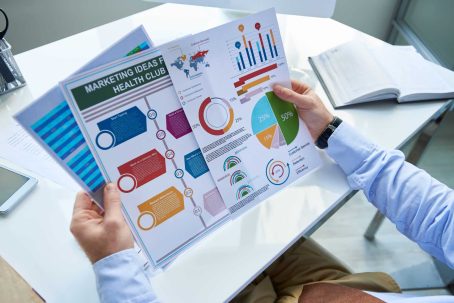All about graphic design in marketing and advertising (2024)

Category:Graphic Design
Publish Date: 2023-10-16 19:11:20
In today’s dynamic landscape of marketing and advertising, success hinges on mastering an art form that has seamlessly blended with science: graphic design. It’s the wizardry of visual communication that not only seizes attention but, more importantly, weaves narratives that resonate deeply with your audience. In the following pages, we will embark on an enriching journey through the multifaceted world of graphic design in marketing and advertising. From tracing its historical lineage to unraveling its fundamental principles and exploring the nuances of branding to navigating the intricate realms of print and digital media, this exploration in marketing & advertising graphic design will furnish you with profound insights into a tool that is as indispensable as it is transformative. Throughout this narrative, we will subtly guide your attention toward the abundant opportunities in graphic design in advertising that await you in the realm of graphic design, logo design, and website design services in Ramikar. In this haven, creativity knows no bounds.




importance of graphic design in the advertising and marketing
In general, the importance of graphic design in the advertising and marketing industry are:- Brand Identity: Graphic design helps establish and reinforce a brand’s identity, making it recognizable and memorable.
- Visual Communication: It translates complex messages into simple, visual forms that are easy for the audience to understand.
- Customer Engagement: Eye-catching designs grab attention and engage potential customers, making them more likely to interact with the brand.
- Emotional Impact: Well-designed visuals can evoke emotions, influencing customer perceptions and decision-making.
- Consistency: Consistent graphic design across all marketing materials ensures a cohesive brand image, building trust with the audience.
- Competitive Advantage: Unique and creative design can set a brand apart from its competitors, making it more appealing to the target market.
- Information Delivery: Infographics and other design elements can present information clearly and concisely, aiding in customer understanding and retention.
- Increased Conversion Rates: Compelling design can guide users through a marketing funnel, leading to higher conversion rates and sales.

Case Studies and Examples
To truly appreciate the impact of graphic design in marketing and advertising, let’s delve into some real-world examples where design transcended aesthetics to become a defining element of brand identity:- Coca-Cola’s Timeless Logo: The Coca-Cola logo, with its iconic red and white script, is a global emblem of refreshment and enjoyment. It’s a testament to the enduring power of a well-crafted logo, which has remained virtually unchanged for over a century. This simplicity speaks volumes about the brand’s promise of joy and refreshment.
- Apple’s Minimalist Aesthetics: Apple’s design ethos is a masterclass in minimalism. From the clean lines of their devices to the intuitive interface of their software, Apple’s design philosophy is characterized by simplicity, elegance, and a relentless focus on user experience. It’s a testament to how design can set a brand apart in the tech industry.
- Nike’s Swoosh: The Nike Swoosh is a prime example of how a simple symbol can become synonymous with a brand’s core values. It symbolizes athleticism, excellence, and the pursuit of greatness. The Swoosh is a reminder that a well-designed symbol can encapsulate the very essence of a brand.
Visual Communication’s Significance in graphic design
Powered by graphic design, visual communication wields a staggering influence in our information-saturated world. To put it into perspective, visuals are processed a mind-boggling 60,000 times faster in the human brain than text. This rapid processing makes graphic design an invaluable tool for conveying complex ideas and stirring emotions swiftly and effectively. In a world where global connectivity is the norm, graphic design in marketing and advertising serves as a universal language, transcending the constraints of words. It bridges gaps, dismantles language barriers, and speaks to people from all walks of life. Whether it’s the euphoria of a Coke advertisement or the solemnity of a social justice poster, graphic design communicates with equal potency to people across the globe.Graphic design historical Perspective
The roots of marketing & advertising graphic design stretch back through the annals of human history. From early civilizations’ cave paintings to the Middle Ages’ intricate manuscripts, symbols, and imagery have long been employed to communicate ideas and narratives. These primal forms of graphic design paved the way for the modern era, where graphic design has metamorphosed into a sophisticated and indispensable discipline. Fast-forward to today and graphic design has transcended the limitations of physical media. It has become an omnipresent force that shapes the very fabric of our visual culture. It’s not just about aesthetics; it’s about the strategic fusion of art and science. Graphic design in marketing and advertising has become a linchpin in marketing and advertising, propelling businesses into the digital age with creativity and precision. It has evolved into a catalyst for innovation, constantly pushing the boundaries of what’s possible in visual storytelling. Suggested article: different types of portrait photographyKey Principles and Elements of Graphic Design in marketing
The world of graphic design in marketing and advertising, is governed by a set of fundamental principles and elements that serve as its guiding stars. Like the North Star to a sailor, these principles provide direction and purpose to every design endeavor. This section will illuminate these principles and elements, unveiling the secrets that transform a blank canvas into a compelling visual masterpiece. Join us on this creative voyage where we dissect typography, explore the psychology of color, harness the power of imagery, and decipher the art of layout and composition.Typography
Typography in marketing & advertising graphic design is akin to the voice in storytelling, it’s not just about the words but how they’re expressed. It goes beyond selecting fonts; it’s about choosing the right typeface, size, spacing, and arrangement to enhance readability and convey the intended tone. Typography can be a subtle persuader in marketing materials, evoking emotions and building trust. For instance, a sleek, sans-serif font might convey a modern, clean image for a technology company. In contrast, a serif font could lend an air of tradition and reliability to a financial institution. The careful selection of typography can create a sense of urgency or excitement, urging consumers to take immediate action. Typography is the hidden persuader, guiding the reader’s emotions and decisions.
Color Theory
Colors are the emotional language of design, and they hold the power to evoke feelings and trigger specific responses. Understanding color psychology is a cornerstone of effective graphic design in marketing and advertising. The right color palette can be a strategic tool for enhancing brand recognition and conveying the desired message. For example, the warm and inviting hues of orange and yellow can evoke feelings of happiness and optimism, making them ideal for brands seeking to create a positive and approachable image. Conversely, blue’s cool, serene tones can instill trust and reliability, making it a popular choice for financial institutions. Harnessing the psychology of color allows graphic designers to tap into the subconscious emotions of the audience and influence their perceptions. To receive free counseling and utilize Ramikar team’s services, please fill out the form below: [elementor-template id=”19523″]Imagery and Illustration
In a world awash with information, high-quality images and illustrations are the visual magnets that draw attention and leave a lasting impression. They serve as your audience’s first point of contact, making their quality and relevance paramount. Whether showcasing products through vivid photos, simplifying complex ideas with infographics, or adding a touch of uniqueness with custom illustrations, visuals are a powerful tool in marketing and advertising. Compelling imagery can tell stories, convey messages, and ignite emotions in a way that text alone cannot. It invites the viewer to engage, explore, and connect with your brand on a deeper level. From the dazzling allure of a fashion catalog to the informative clarity of an annual report, imagery, and illustration play a pivotal role in bringing your message to life in your approach to graphic design in marketing and advertising.Layout and Composition
Effective layout and composition are the architects of visual communication. They are the designers’ blueprints for guiding the viewer’s eye, organizing information, and creating a harmonious and engaging design. It’s about finding the delicate balance between text and visuals, creating a flow that captivates and informs. Consider a magazine layout, where the arrangement of articles, images, and advertisements directs the reader through the publication, ensuring they absorb the content logically and engagingly. In marketing & advertising graphic design, layout and composition are strategic tools that influence how your audience perceives and interacts with your message. It’s the art of choreographing visual elements to tell your story with impact and finesse. If you wish, you can also use our photography services in Vancouver.Branding and Identity with graphic design
Establishing a strong brand identity is your doorway to graphic design in marketing and advertising and also is like crafting your company’s unique fingerprint in the ever-competitive business world. This mark sets you apart in a sea of competitors. In this section, we’ll embark on a journey to unravel the intricacies of branding and identity. Discover how consistent design elements and a thoughtfully designed logo can become the bedrock of brand recognition, trust, and loyalty. Explore how branding transcends mere visuals to become the heartbeat of your company’s narrative, connecting with your audience personally.Building Brand Recognition
In the sprawling marketplace where countless brands vie for attention, the ability to stand out and be recognized is paramount, which is where consistent marketing & advertising graphic design takes center stage. It’s not just about creating visually appealing marketing materials; it’s about crafting a cohesive visual identity that becomes synonymous with your brand. Imagine a consumer encountering your packaging, a social media post, or an advertisement. You’ve achieved a significant milestone when they instantly associate these visuals with your brand. This kind of consistency fosters trust and loyalty. It tells your audience they can expect quality, reliability, and values associated with your brand every time they engage. Building brand recognition is about imprinting your brand’s image in the minds of consumers, ensuring that you’re the first choice when they’re in need.
Logo Design
In graphic design in advertising, a well-designed logo is not just an artwork; it’s a symbol that encapsulates the essence of your business. It’s a visual shorthand that communicates who you are and what you stand for. Think of iconic logos like the bitten apple of Apple Inc. or the swoosh of Nike—these symbols have transcended their corporate origins to become universally recognized icons. Investing in professional logo design is not an expense; it’s a strategic move that pays dividends in brand recognition, trust, and memorability. We suggest you read the logo design step by step.Visual Consistency
Visual chaos is the enemy of brand trust. Inconsistent design elements scattered across different marketing channels can confuse and alienate your audience. Visual consistency in graphic design in marketing and advertising, is the glue that holds your brand identity together. It involves maintaining a harmonious marriage of design elements, such as color schemes, typography, and imagery, across all touch points, be it your website, social media, printed materials, or even the packaging of your products. When your audience encounters a consistent visual language, they don’t just see it; they feel it. It reinforces your brand identity, making it instantly recognizable and engenders consumer trust. Imagine a world-famous cola brand suddenly changing its iconic red logo to green. The disruption in visual consistency could create confusion and erode trust. Consistency is a promise to your audience that you are who you say you are and that you stand by your values. It’s the unspoken contract that builds lasting connections between brands and consumers.Print and Digital Design
In the age of multimedia communication, where the physical and the digital converge, the realm of graphic design in marketing and advertising, takes on a dual identity: print and digital. This section unravels the nuances of print and digital design, highlighting their distinct characteristics and the art of seamless adaptation.Print vs. Digital
The juxtaposition of print and digital design presents a fascinating dichotomy in graphic communication. Each medium brings its unique set of advantages and challenges. Print materials offer a tactile and sensory experience through something you can hold, feel, and interact with within the physical world. Brochures, posters, and business cards are print materials that can leave a lasting impression. On the other hand, digital graphic design in advertising operates in the dynamic realm of screens and devices. It requires a focus on responsive layouts that adapt to various screen sizes, from the expansive canvas of desktop monitors to the intimate spaces of smartphones. Digital design allows for interactivity, animations, and real-time updates, offering an immersive and engaging experience. However, the most effective strategies often embrace both mediums. Print materials can drive brand recognition and establish a tangible connection with your audience. Digital platforms provide reach, versatility, and the ability to gather data on user interactions. Together, they form a cohesive strategy that caters to diverse consumer preferences and behaviors. Suggested content: what is videography?Responsive Design
In graphic design in marketing and advertising, responsive design ensures that the user experience remains consistent and enjoyable, whether someone is browsing on a desktop computer, a tablet held vertically, or a smartphone in landscape mode. It’s about more than just fitting content onto different screens; it’s about optimizing the layout, font sizes, and interactions to create a fluid and visually pleasing experience. Failing to implement responsive design can frustrate users navigating a non-mobile-friendly website or interacting with emails that aren’t tailored to their device. It can also result in missed opportunities for engagement and conversions. In today’s interconnected world, responsive design is not just a best practice; it’s a fundamental requirement to meet the diverse needs of your audience.
Tools and Resources
Professional designers of graphic design in marketing and advertising, rely on industry-standard software like Adobe Creative Suite to bring their creative visions to life. This software suite empowers designers to create everything from stunning visuals to intricate layouts with precision and finesse. Additionally, online platforms such as Canva have democratized design, making it accessible even to beginners. With user-friendly interfaces and a wealth of templates and resources, Canva has enabled individuals and businesses to produce eye-catching designs without a steep learning curve.Use Graphic Design for Marketing and Advertising!
In the creative hub of Ramikar, the possibilities for harnessing the power of graphic design in advertising, logo design, and website design services are boundless. This vibrant group of people fosters innovation and creativity, making it an ideal place to collaborate with skilled professionals who understand local and global design dynamics. Don’t miss the opportunity to elevate your marketing and advertising efforts to new heights. Whether you’re a startup looking to establish a brand identity or an established business seeking to refresh your visual presence, graphic design is your ally in achieving these goals.FAQs
Why is graphic design crucial in marketing and advertising? Graphic design enhances visual communication, making it more engaging and effective. It helps convey messages and build brand recognition. How does color theory impact marketing design? Color theory influences emotions and perceptions. The right color palette can evoke desired feelings and reinforce brand identity.Recent Articles:

Video Marketing Canada: Best Strategies for 2025
2 months ago
5 min 25 sec read

Photography Services Canada: For Web & Social Media Use
2 months ago
5 min 2 sec read

Logo Design Canada: Create a Logo That Truly Stands Out
3 months ago
4 min 38 sec read
Let us help !
Related Posts
Comments
0
0
votes
Article Rating
Subscribe
Login
0 Comments
Oldest
Newest
Most Voted
Inline Feedbacks
View all comments






